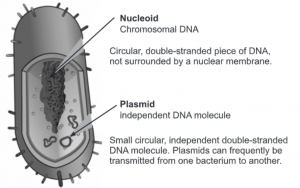Contents:
Plasmid, its Types, and function
General Properties of Plasmid and its Types
In addition to chromosomal DNA most bacteria possess extra-chromosomal genetic materials. These materials are known as plasmids. The general properties of plasmids are a follows:
- They are small extrachromosomal pieces of genetic material that can replicate autonomously within the host cell.
- They consist of a circular piece of double-stranded DNA.
- They can integrate with each other and with the host chromosome which may lead to an exchange of genetic material (episome).
- They are not essential for normal life and cell survival.
- They may contain genetic information for controlling their own replication.
- Plasmids may be lost spontaneously or by curing agents.
- They can promote their own transfer by host cell conjugation.
- Plasmids may have some additional properties such as drug or heavy metal resistance, bacteriocin production, toxigenicity, etc.
- Plasmids vary both in numbers per cell and in size. Each contains 50 to 100 genes.
- Plasmids can be classified as conjugative or self-transmissible and non-conjugative of nonself transmissible or determinants.
- The conjugative plasmids are large and self-transmissible. They have an apparatus through which they can mediate their own transfer to another cell, e.g. R, F, and bacteriocinogen plasmids.
- Those plasmids which do not possess information for self-transfer to another cell are known as non-conjugative plasmids. They can be transferred with the help of transfer factors such as colicin plasmid (Col ) and through the agency of bacteriophages (transduction). Several properties of bacteria are attributed to extrachromosomal DNA.

Types of Plasmid
-
Fertility plasmids:
The plasmid conferring maleness is known as the fertility (F) plasmid. Conjugation in bacteria always proceeds from the male donor cell to the female recipient cell. Microbial cells containing this plasmid are designated F’ cells and cells without fertility plasmid are designated F cells. When F cells conjugate with F female cells then all the recipients become F cells. Fertility plasmids code for the genes needed to produce the pili and for the enzymes involved in the transfer of the plasmid.
-
Composite drug-resistant plasmids (Resistance transfer factor – RTF):
Many microbial cells possess resistance to multiple drugs and this resistance can be genetically transferred by conjugation. The genes for multiple drug resistance are contained in a DNA plasmid called the r-determinant. This DNA can be mobilized by the resistance transfer factor. The r-determinant plasmid becomes conjugative when it combines with the resistance transfer factor. The two molecules together are called the R-factor. The discovery of RTF was first made in Japan when a strain of Shigella dysentriae was found to be simultaneously resistant to sulphonamides, streptomycin, chloramphenicol, and tetracycline. The RTF region of several R-factors has been characterized and found to have molecular weights of 60 million daltons while the r-determinants have 10 million daltons. These two segments of the RTF have been found to have different G + C content. These plasmids are genetically labile.
-
Bacteriocin plasmids:
Bacteriocins are protein toxins produced by certain bacteria which inhibit the growth of related bacteria. The formation of a bacteriocin is due to a corresponding plasmid (bacteriocinogen). Ultraviolet rays can induce bacteriocinogenic strains to form and release the bacteriocins. The bacteriocins produced by strains of Escherichia coli are called colicins (B, C, D, E, F, G, etc.). Bacteriocins produced by Serratia marcescens, Pasteurella pestis, Bacillus megaterium, and Clostridium perfringens are marcescins, pesticins, megacins, and clostocins respectively.
-
Degradative plasmids:
The degradative plasmids possess genes that control the degradation of organic and inorganic compounds. Pseudomonas species are capable of metabolizing a large group of organic compounds. The enzymes for octane degradation are contained in a plasmid of Pseudomonas putida. The comphor plasmid, octane plasmid, or salicylate plasmid control the degradation of camphor, octane, or salicylate respectively. These plasmids are transmissible by conjugation within and between Pseudomonas strains.
Function of Plasmid
- They may contain genes that enhance the survival of an organism, either by killing other organisms or by defending the host cell by producing toxins.
- F-plasmids, contain transfer genes that allow genes to be transferred from one bacterium to another through conjugation.
- Resistance or R plasmids contain genes that help a bacterial cell defend against environmental factors such as poisons or antibiotics.
- When a virulence plasmid is inside a bacterium, it turns that bacterium into a pathogen, which is an agent of disease. The bacterium Escherichia coli has several virulence plasmids. Certain strains of E. coli can cause severe diarrhea and vomiting.
- Degradative plasmids help the host bacterium digest compounds that are not commonly found in nature, such as camphor, xylene, toluene, and salicylic acid. These plasmids contain genes for special enzymes that break down specific compounds.
- Col plasmids contain genes that make bacteriocins (also known as colicins), which are proteins that kill other bacteria and thus defend the host bacterium.
REFERENCES